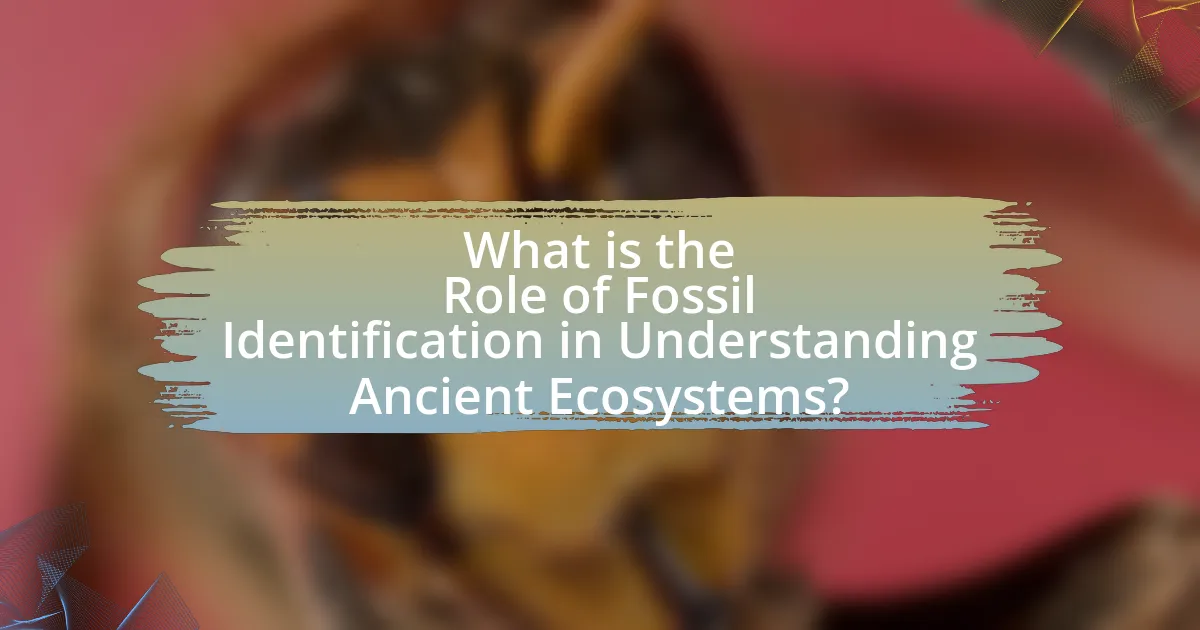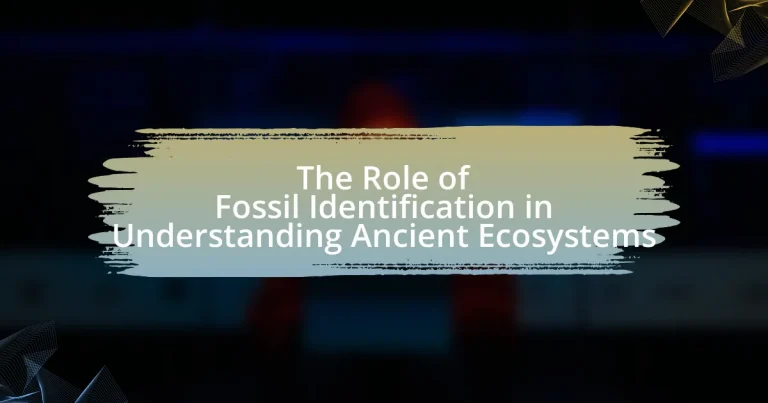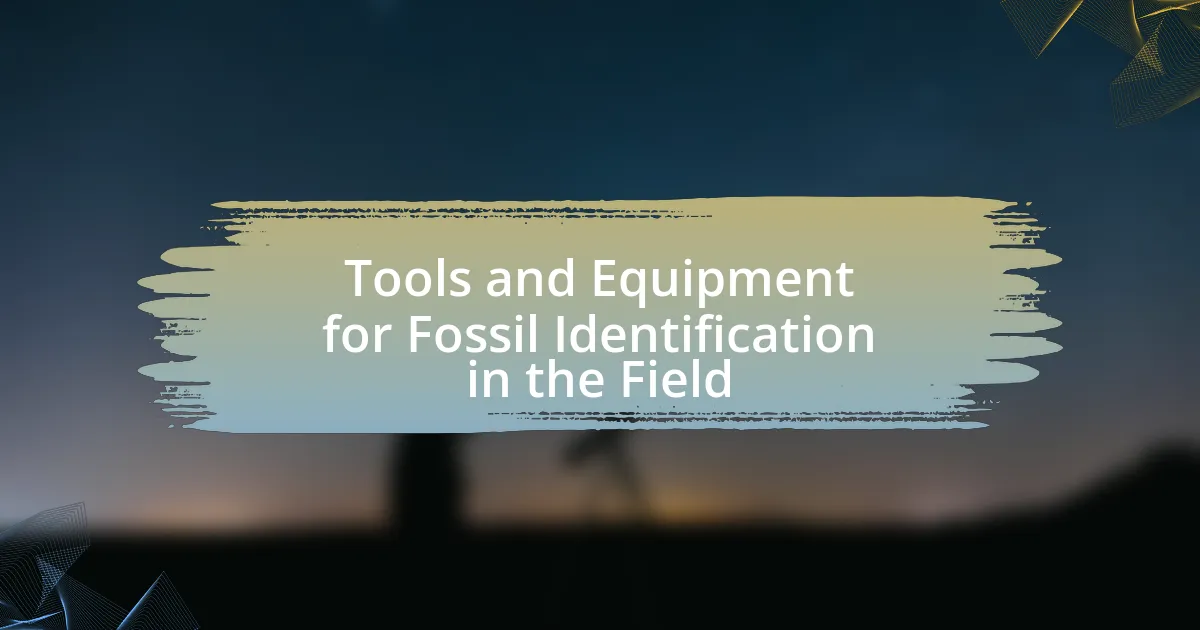Fossil identification is essential for understanding ancient ecosystems, as it provides insights into the organisms that existed, their interactions, and the environmental conditions of their time. By analyzing various fossil types, including index, body, and trace fossils, scientists can reconstruct past biodiversity, climate conditions, and ecological dynamics. The article explores the methods used in fossil identification, the challenges faced by researchers, and the role of technology in enhancing accuracy. Additionally, it discusses how fossil records inform us about extinction events and ecosystem changes, ultimately highlighting the significance of fossil identification in piecing together Earth’s biological history.

What is the Role of Fossil Identification in Understanding Ancient Ecosystems?
Fossil identification plays a crucial role in understanding ancient ecosystems by providing insights into the types of organisms that existed, their interactions, and the environmental conditions of the time. By analyzing fossilized remains, paleontologists can reconstruct past habitats, determine biodiversity levels, and infer ecological dynamics. For instance, the discovery of specific plant fossils alongside animal remains can indicate the types of vegetation that supported herbivores, which in turn informs about predator-prey relationships. Additionally, isotopic analysis of fossils can reveal climatic conditions, such as temperature and precipitation patterns, further enhancing our understanding of ancient ecosystems.
How does fossil identification contribute to our knowledge of ancient ecosystems?
Fossil identification significantly enhances our understanding of ancient ecosystems by providing concrete evidence of past life forms and their interactions within specific environments. Through the analysis of fossilized remains, scientists can reconstruct the biodiversity, climate conditions, and ecological dynamics of historical periods. For instance, the discovery of specific plant and animal fossils allows researchers to infer the types of habitats that existed, such as wetlands or forests, and how these ecosystems responded to climatic changes over millions of years. This is supported by findings from the Late Cretaceous period, where fossil evidence indicates a rich diversity of dinosaurs coexisting with flowering plants, illustrating complex food webs and ecological relationships. Thus, fossil identification serves as a crucial tool in piecing together the intricate puzzle of Earth’s biological history.
What types of fossils are most significant for ecosystem studies?
The types of fossils most significant for ecosystem studies are index fossils, body fossils, and trace fossils. Index fossils, such as trilobites and ammonites, are crucial for dating and correlating the age of rock layers, providing insights into the temporal aspects of ecosystems. Body fossils, which include remains of plants and animals, help reconstruct past biodiversity and ecological interactions. Trace fossils, like footprints and burrows, reveal behavioral patterns and environmental conditions of ancient organisms. Collectively, these fossil types enable scientists to understand the structure and dynamics of ancient ecosystems, as evidenced by studies that link fossil records to climate changes and extinction events.
How do different fossil types inform us about ancient environments?
Different fossil types provide critical insights into ancient environments by revealing information about past climates, ecosystems, and biological interactions. For instance, plant fossils, such as leaves and pollen, indicate the types of vegetation that thrived in specific climates, helping to reconstruct ancient landscapes. Marine fossils, like coral and foraminifera, reflect ocean conditions and can indicate temperature and salinity levels, which are essential for understanding historical climate changes. Additionally, vertebrate fossils, including bones and teeth, offer clues about the diets and habitats of ancient animals, allowing scientists to infer the ecological dynamics of their environments. These fossil records serve as direct evidence of the conditions that existed millions of years ago, enabling researchers to piece together the complex history of Earth’s ecosystems.
Why is fossil identification crucial for reconstructing past biodiversity?
Fossil identification is crucial for reconstructing past biodiversity because it allows scientists to accurately determine the types and diversity of organisms that existed in different geological periods. By identifying specific fossils, researchers can piece together the ecological dynamics and evolutionary history of ancient ecosystems. For instance, the discovery of diverse fossilized remains in the Burgess Shale formation reveals a complex marine ecosystem from the Cambrian period, highlighting the rapid diversification of life during that time. This identification process not only aids in understanding species interactions and environmental conditions but also provides insights into how biodiversity has changed over millions of years, informing current conservation efforts.
What methods are used in fossil identification?
Fossil identification employs several methods, including morphological analysis, stratigraphic correlation, and radiometric dating. Morphological analysis involves examining the physical characteristics of fossils to classify them and determine their evolutionary relationships. Stratigraphic correlation uses the layers of rock in which fossils are found to establish their relative ages and environmental contexts. Radiometric dating provides absolute ages for fossils by measuring the decay of radioactive isotopes within the surrounding materials. These methods collectively enhance our understanding of ancient ecosystems by providing insights into the biodiversity and environmental conditions of past geological periods.
How do these methods enhance our understanding of species interactions?
Fossil identification methods enhance our understanding of species interactions by providing direct evidence of past ecological relationships. These methods allow researchers to reconstruct ancient ecosystems, revealing how different species coexisted, competed, and interacted with one another. For instance, the analysis of fossilized remains can indicate predator-prey dynamics, symbiotic relationships, and the impact of environmental changes on species behavior. Studies, such as those published in the journal “Paleobiology,” demonstrate that examining isotopic compositions in fossils can elucidate dietary habits and habitat preferences, further clarifying the roles species played in their ecosystems.
What challenges do scientists face in fossil identification?
Scientists face several challenges in fossil identification, primarily due to the incomplete nature of the fossil record. Fossils are often fragmented, making it difficult to determine their original morphology and taxonomic classification. Additionally, the preservation conditions can vary significantly, leading to alterations in the physical characteristics of fossils, which complicates identification. For instance, taphonomic processes such as erosion, compaction, and mineralization can obscure key features necessary for accurate classification. Furthermore, the vast diversity of ancient organisms and the potential for convergent evolution add layers of complexity, as similar traits may arise independently in unrelated lineages. These factors collectively hinder scientists’ ability to accurately identify and classify fossils, impacting our understanding of ancient ecosystems.
How do preservation conditions affect fossil identification?
Preservation conditions significantly influence fossil identification by determining the extent to which organic materials are preserved and the clarity of morphological features. Factors such as temperature, humidity, and the presence of minerals during fossilization can enhance or obscure details critical for accurate identification. For instance, fossils preserved in anoxic environments tend to retain more original structures, making it easier for paleontologists to classify them accurately. Conversely, fossils subjected to high temperatures or acidic conditions may undergo diagenesis, leading to the loss of identifiable characteristics. Studies have shown that well-preserved fossils, such as those found in amber or tar pits, provide clearer insights into the organism’s anatomy and ecology, thereby facilitating more precise identification and understanding of ancient ecosystems.
What role does technology play in overcoming these challenges?
Technology plays a crucial role in overcoming challenges related to fossil identification and understanding ancient ecosystems. Advanced imaging techniques, such as CT scanning and 3D modeling, allow researchers to visualize and analyze fossils in detail without damaging them, facilitating more accurate identification. Additionally, machine learning algorithms can process vast datasets of fossil records, identifying patterns and correlations that human researchers might overlook. For instance, a study published in the journal “Nature” demonstrated how AI can classify fossils with an accuracy rate exceeding 90%, significantly enhancing the efficiency of paleontological research. These technological advancements not only streamline the identification process but also contribute to a deeper understanding of ancient biodiversity and ecosystem dynamics.
How does fossil identification link to the study of ancient climate change?
Fossil identification is crucial for studying ancient climate change as it provides evidence of past life forms and their environments, which reflect historical climate conditions. By analyzing the types of fossils found in specific geological layers, scientists can infer the climate during the time those organisms lived. For instance, the presence of certain plant fossils, like ferns, indicates a warm and humid climate, while the discovery of marine fossils in terrestrial deposits suggests significant geological changes and climate shifts. This method of correlating fossil types with climatic conditions has been validated through numerous studies, including the examination of sediment cores that reveal changes in biodiversity and ecosystem structure in response to climate fluctuations over millions of years.
What insights can we gain from fossil records about ancient ecosystems?
Fossil records provide critical insights into ancient ecosystems by revealing the types of organisms that existed, their interactions, and the environmental conditions of their habitats. For instance, the presence of specific plant fossils can indicate the climate and geography of an area, while animal fossils can illustrate food webs and predator-prey relationships. Studies, such as those analyzing the fossilized remains of dinosaurs and their flora, show how ecosystems evolved over time in response to climatic changes, such as the transition from the Mesozoic to the Cenozoic era. These findings demonstrate that fossil records are essential for reconstructing past biodiversity and understanding ecological dynamics.
How do fossil records help us understand extinction events?
Fossil records provide critical evidence for understanding extinction events by documenting the presence and absence of species over geological time. These records reveal patterns of biodiversity loss and recovery, allowing scientists to identify the timing and potential causes of mass extinctions, such as climate change, volcanic activity, or asteroid impacts. For instance, the fossil record indicates that the Cretaceous-Paleogene extinction event, which occurred approximately 66 million years ago, led to the disappearance of about 75% of Earth’s species, including the dinosaurs, correlating with a significant asteroid impact. This correlation is supported by the presence of a layer of iridium-rich clay found in the geological strata, which serves as a marker for this event. Thus, fossil records are essential for reconstructing past ecosystems and understanding the dynamics of extinction and recovery.
What patterns can be observed in the fossil record regarding ecosystem changes?
Patterns observed in the fossil record regarding ecosystem changes include shifts in species diversity, changes in dominant taxa, and evidence of mass extinction events. For instance, the fossil record shows that during the Permian-Triassic extinction event, approximately 90% of marine species disappeared, indicating a significant ecosystem collapse. Additionally, the transition from the Mesozoic to the Cenozoic era reveals a shift from dominance by reptiles to mammals, highlighting changes in ecological niches and climate conditions. These patterns are supported by stratigraphic data and isotopic analysis, which provide insights into past environmental conditions and biological responses to climate change.
What are the best practices for fossil identification in paleontology?
The best practices for fossil identification in paleontology include thorough field documentation, careful excavation techniques, and comparative analysis with existing fossil records. Field documentation involves recording the precise location, stratigraphy, and context of the fossil find, which is crucial for understanding its geological and ecological significance. Careful excavation techniques, such as using appropriate tools and methods to minimize damage, ensure the integrity of the fossil is maintained. Comparative analysis with existing fossil records allows paleontologists to accurately classify and identify fossils based on morphological characteristics and evolutionary relationships. These practices are supported by the systematic approach outlined in “Principles of Paleontology” by David M. Raup and Steven M. Stanley, which emphasizes the importance of meticulous methods in fossil identification for reconstructing ancient ecosystems.





